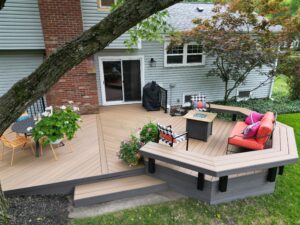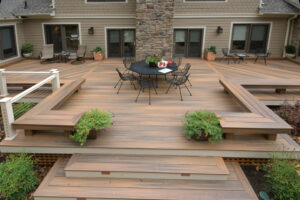How to Choose the Best Material for Your Backyard Deck
A backyard deck is more than just an extension of your home—it’s a space for relaxation, social gatherings, and outdoor enjoyment. Choosing the right material for your deck is crucial to ensure durability, aesthetics, and long-term value. With various options available, it’s important to understand the characteristics of each material before making a decision.
Understanding Your Needs and Climate
 Before selecting a decking material, consider your lifestyle, maintenance preferences, and the climate in your area. If you live in a region with harsh winters or intense heat, some materials may be more resistant to weathering than others. Think about how often you’ll use the deck, whether you prefer a natural or modern look, and how much maintenance you’re willing to commit to over time.
Before selecting a decking material, consider your lifestyle, maintenance preferences, and the climate in your area. If you live in a region with harsh winters or intense heat, some materials may be more resistant to weathering than others. Think about how often you’ll use the deck, whether you prefer a natural or modern look, and how much maintenance you’re willing to commit to over time.
The Appeal of Natural Wood
Wood has long been a popular choice for backyard decks due to its classic and natural beauty. There are several types of wood to choose from, each with distinct characteristics. Hardwoods like ipe, teak, and mahogany offer exceptional durability and resistance to moisture, but they tend to be more expensive. Softwoods such as cedar and redwood provide a warm, inviting appearance and are naturally resistant to decay, making them a good option for those who prefer a balance of affordability and longevity.
One factor to consider with wood decking is maintenance. Regular sealing, staining, or painting is necessary to prevent fading, moisture damage, and insect infestation. Without proper care, wood decks can warp, crack, or develop mold over time. However, for homeowners who appreciate the timeless appeal of real wood, the effort may be worthwhile.
The Durability of Composite Decking
For those seeking a low-maintenance alternative, composite decking has become an increasingly popular option. Made from a blend of wood fibers and recycled plastic, composite boards are designed to mimic the appearance of wood while offering superior resistance to weather, insects, and rot. Unlike natural wood, composite decking does not require staining or sealing and is available in a variety of colors and textures.
One of the advantages of composite decking is its longevity. It resists fading, warping, and splintering, making it an excellent choice for homeowners who want a deck that maintains its appearance with minimal upkeep. However, composite decking can be more expensive upfront compared to wood, and some lower-quality options may become hot under direct sunlight. Still, for those who value durability and ease of maintenance, it is a worthwhile investment.
The Strength of PVC and Vinyl Decking
 Another option for those looking for a virtually maintenance-free deck is PVC or vinyl decking. These synthetic materials are highly resistant to moisture, mold, and insects, making them ideal for areas with high humidity or frequent rain. Unlike wood or composite, PVC decking does not absorb water, which helps prevent issues like rot or mildew growth.
Another option for those looking for a virtually maintenance-free deck is PVC or vinyl decking. These synthetic materials are highly resistant to moisture, mold, and insects, making them ideal for areas with high humidity or frequent rain. Unlike wood or composite, PVC decking does not absorb water, which helps prevent issues like rot or mildew growth.
One of the main benefits of PVC decking is its lightweight nature, which makes installation easier compared to other materials. Additionally, it is available in a range of colors and finishes, allowing homeowners to customize the look of their deck. While some may find that PVC lacks the warmth and authenticity of natural wood, its durability and long lifespan make it a practical choice for those prioritizing longevity and minimal upkeep.
The Affordability of Pressure-Treated Wood
For homeowners on a budget, pressure-treated wood is one of the most cost-effective decking materials available. Treated with chemicals to resist insects, rot, and decay, pressure-treated lumber provides a sturdy and long-lasting option for outdoor decks.
While this material is widely used due to its affordability and availability, it does require ongoing maintenance. Regular sealing and staining are necessary to prevent the wood from drying out, cracking, or absorbing moisture. Some homeowners may also be concerned about the chemical treatments used in pressure-treated wood, though newer treatments are considered safer than older versions.
The Eco-Friendly Option of Bamboo
 Bamboo decking has gained popularity as an environmentally friendly alternative to traditional wood. As a rapidly renewable resource, bamboo offers a sustainable option for homeowners looking to reduce their environmental footprint. It is naturally resistant to moisture and pests, making it a durable choice for outdoor spaces.
Bamboo decking has gained popularity as an environmentally friendly alternative to traditional wood. As a rapidly renewable resource, bamboo offers a sustainable option for homeowners looking to reduce their environmental footprint. It is naturally resistant to moisture and pests, making it a durable choice for outdoor spaces.
Bamboo decking often comes in composite or engineered forms, where it is treated and compressed to enhance its durability. While it provides an attractive, modern look, it is essential to ensure that the bamboo decking chosen is properly treated to withstand outdoor conditions. Some varieties may require sealing to maintain their integrity over time.
Choosing the Right Material for Your Lifestyle
Selecting the best decking material ultimately depends on your budget, aesthetic preferences, and willingness to perform maintenance. If you love the natural charm of wood and are willing to invest time in upkeep, hardwoods or cedar may be the right choice. If convenience and longevity are priorities, composite, PVC, or vinyl decking could be a better fit. For those seeking an affordable yet durable option, pressure-treated wood remains a solid contender. And if sustainability is a key consideration, bamboo decking offers an eco-friendly solution.